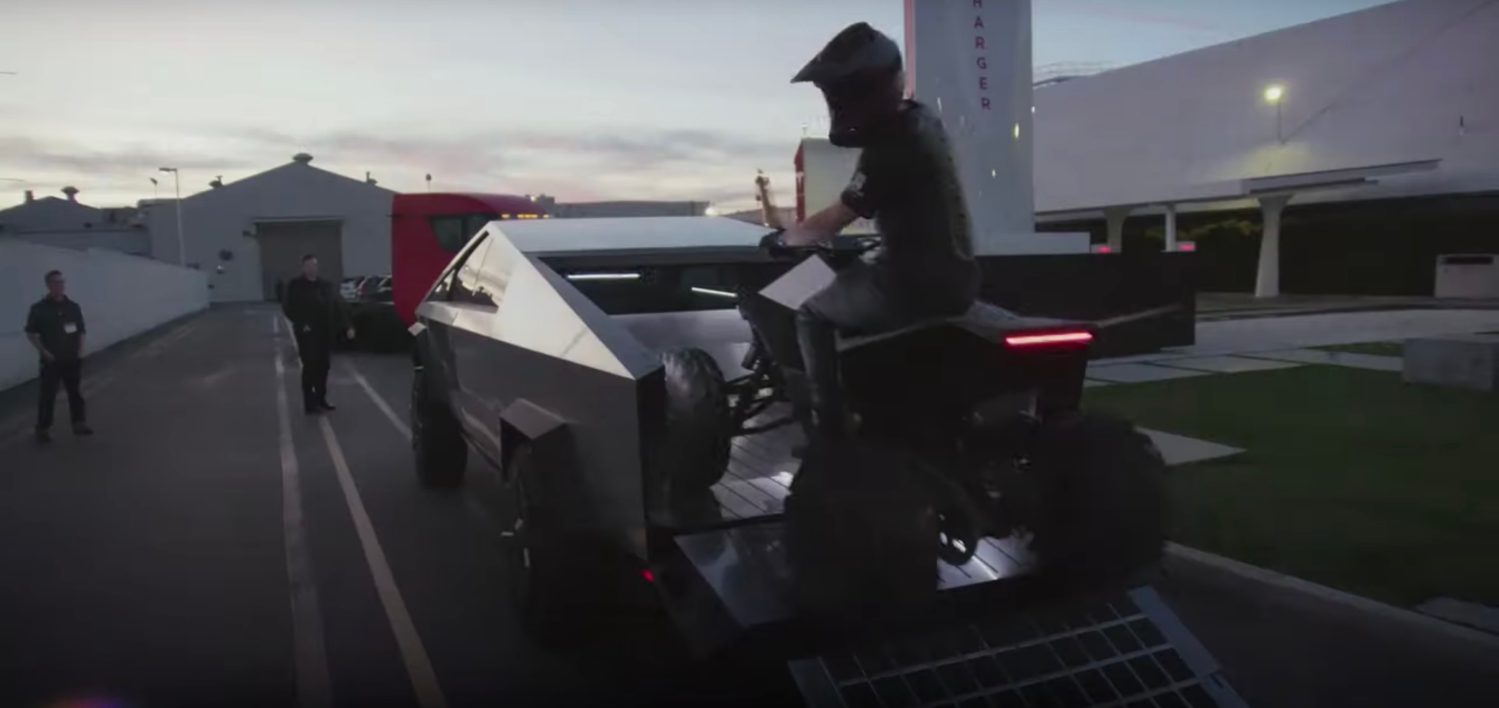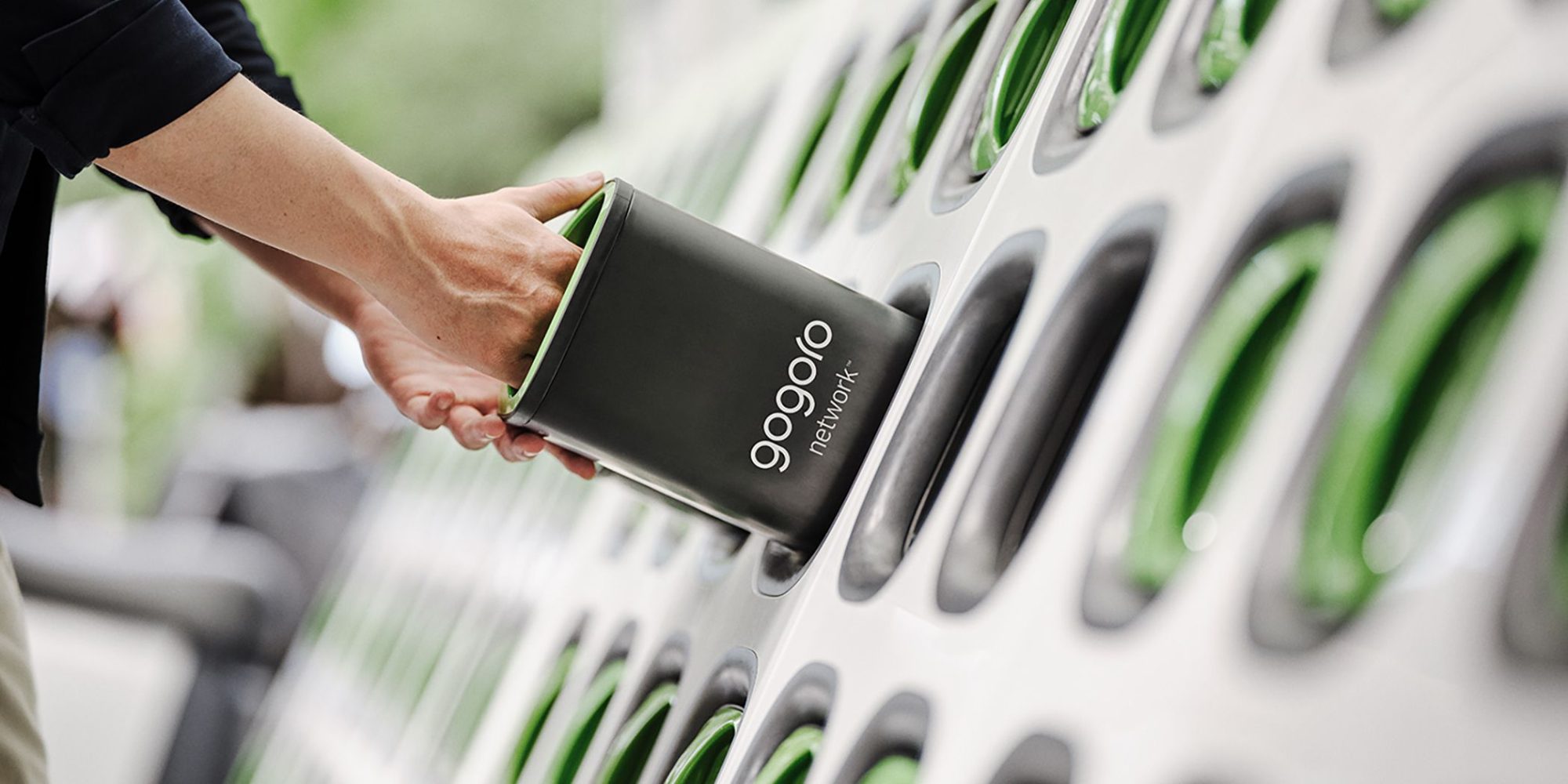
We are getting some rare new Tesla Cybertruck and electric ATV footage featured on the new season of Jay Leno’s Garage.
Continue reading New Tesla Cybertruck and electric ATV footage on new Jay Leno’s Garage
We are getting some rare new Tesla Cybertruck and electric ATV footage featured on the new season of Jay Leno’s Garage.
Continue reading New Tesla Cybertruck and electric ATV footage on new Jay Leno’s Garage
Alleged pictures of the production version of the BMW iX3 electric SUV have leaked ahead of the start of production.
Continue reading BMW iX3 electric SUV: Are these leaked pictures of the production version?
Gogoro is a Taiwanese-based electric scooter and battery manufacturer that has gobbled up market share while competing against traditional gas-powered scooters in its home market. Fans of the company’s electric scooters and novel battery swap technology have long pined for Gogoro to enter the US and Europe. And now that company has announced plans to enter the US market in May under the brand name Eeyo, followed by a European entry later this summer.
But there’s a catch.
They’re going to bring an electric bicycle first.
Gogoro reached out to Electrek with the announcement and was able to share just a few details at the moment.
The electric bicycle line from Gogoro will be known as Eeyo. It is set to launch in next month in the US, which will be the first market that Eeyo enters.
The e-bike won’t be available in Gogoro’s home market of Taiwan until later this summer. At that time, Gogoro will also roll the Eeyo brand into Europe.
We don’t have many other details yet, but we do get one more clue courtesy of Eeyo’s Facebook page. A question remained about whether Gogoro’s upcoming electric bicycle would be similar to US and European bicycles, with traditionally large wheels and narrow seats, or more like popular Asian electric bicycles, which often feature smaller scooter-style wheels and moped seats.

Gogoro’s latest teaser reveals a large diameter bicycle wheel and narrow tire, indicating that the Eeyo will be a more traditional electric bicycle. The company goes on to refer to the Eeyo as “A truly ultralight ebike. Nothing else even comes close.” There also appears to be a Presta valve in the wheel, further supporting the theory that the Eeyo will be closer to a lightweight road bike than a traditionally heavy electric scooter or moped.
While Gogoro’s international ambitions have been clear for some time, the Eeyo electric bicycle move comes as a surprise. The company rolled out a new line of smaller electric scooters destined for the international market, with the first scooters soon headed for Tel Aviv, Israel.
Gogoro has traditionally marketed itself as a battery company or an energy company, based on its popular and innovative battery swapping architecture designed for its electric scooters.
The company has thousands of battery swap stations around Taiwan, where riders can pull in and swap a battery in seconds. The stations can also be used for energy storage, powering the local grid during blackouts.
It is too soon to say whether Gogoro will use the same batteries in its upcoming Eeyo electric bicycles. The move would be unlikely though, as the batteries hold approximately 1.3 kWh of energy. That’s more than twice the battery capacity of a standard electric bicycle and is likely more battery than a self-claimed “truly ultralight ebike” would carry.
But considering May is baring down on us, we’ll likely have more details soon.
Until then, help us speculate wildly in the comment section below. What will the specs be? What will the bike look like? I want to hear your thoughts!
Source: Electrek

/cdn.vox-cdn.com/uploads/chorus_image/image/66703771/2._Messenger_Rooms_MAIN_Desktop.0.jpg?w=980&ssl=1)
Facebook is rolling out a suite of new products to expand its capabilities in video chat. The company today announced Messenger Rooms, a tool for starting virtual hangouts with up to 50 people and allowing friends to drop in on you whenever they like. It’s also doubling the capacity of video calls on WhatsApp from four people to eight, adding video calls to Facebook Dating, and adding new live-streaming features to both Facebook and Instagram.
CEO Mark Zuckerberg announced the features in a live stream today. In an interview with The Verge, Zuckerberg said the new video features were built in line with the company’s shift toward creating more private messaging tools.
“Video presence isn’t a new area for us,” he said. “But it’s an area that we want to go deeper in, and it fits the overall theme, which is that we’re shifting more resources in the company to focus on private communication and private social platforms, rather than just the traditional broader ones. So this is a good mix: we’re building tools into Facebook and Instagram that are helping people find smaller groups of people to then go have more intimate connections with, and be able to have private sessions with.”
:no_upscale()/cdn.vox-cdn.com/uploads/chorus_asset/file/19922591/1.jpg?w=980&ssl=1)
The moves come as the global pandemic has forced hundreds of millions of people to stay indoors and rely on digital tools for nearly all of their work, school, and play. More than 700 million people are now making calls on Facebook Messenger and WhatsApp every day.
But competitors are also surging. Zoom, which began life as a simple tool for business videoconferencing, rocketed from 10 million users in December to more than 300 million today. Houseparty, an app for virtual hangouts with friends that Facebook had previously cloned before abandoning the project last year, now routinely hovers at the top of app store download charts. It gained 50 million users over the past month.
The rapid growth of alternative social products has always been cause for concern at the famously paranoid Facebook, which devotes significant resources to monitoring emerging social products and then acquiring the companies behind them or copying their features. While we are still in the first few months of the COVID-19 pandemic, it’s already clear that consumer behavior is changing to cope with it — and that Facebook’s existing product lineup has not met demand.
:no_upscale()/cdn.vox-cdn.com/uploads/chorus_asset/file/19922601/3._Messenger_Rooms___News_Feed_Image.jpg?w=980&ssl=1)
Of everything announced today, Messenger Rooms promises to be the most significant. The feature, which Facebook says will be available in the company’s products globally sometime in the next few weeks, will allow up to 50 people to join a call. The room’s creator can decide whether it’s open to all or lock it to prevent uninvited guests from joining. You’ll be able to start a room from Messenger and Facebook to start. Later, rooms will come to Instagram Direct, WhatsApp, and Portal. Guests can join a room regardless of whether they have a Facebook account.
While in a room, you can play with Facebook’s augmented reality filters or swap out your real-life background for a virtual one. Some backgrounds offer 360-degree views of exotic locales, the company said. And a new slate of AR filters will help brighten up dark rooms or touch up users’ appearances.
Room calls are not end-to-end encrypted, but Facebook says it does not view or listen to calls. The creator of a room can remove participants at any time, and rooms where illicit behavior is taking place can be reported to Facebook. (WhatsApp video calls are end-to-end encrypted, offering an extra layer of protection to users.)
:no_upscale()/cdn.vox-cdn.com/uploads/chorus_asset/file/19922603/4._Messenger_Rooms__Groups_Image.jpg?w=980&ssl=1)
Zoom saw a surge in malicious behavior as it became the world’s default meeting app, with racist, bigoted, and pornographic “Zoombombings” roiling meetings all over the world. Zuckerberg said Messenger Rooms were designed with strong privacy controls, and that the feature’s reliance on connections with your real-life friends and family make it less likely that it will be used to harass people. For groups where people don’t know each other as well, moderators will be able to kick people out of rooms.
“A lot of the time that I’ve spent on this over the last few weeks as we’ve been building this out and getting ready to ship has been on privacy, security, integrity reviews, and how do we make sure that a lot of the use cases that that have been problematic around Zoom are not going to be things that are replicated here,” he said.
Facebook Live will add back a feature called Live With that enables users to invite another person to stream with them. The donate button will become available on live streams, allowing users to raise money directly from their broadcasts in the countries where fundraisers are available.
:no_upscale()/cdn.vox-cdn.com/uploads/chorus_asset/file/19922605/11._Instagram_Live_Image.jpg?w=980&ssl=1)
Instagram will begin allowing users to post live streams to IGTV as well as to Instagram stories after they finish a stream, and Instagram Live broadcasts will become available on the desktop for the first time.
Users with Facebook’s Portal display will also get the ability to go live to pages and groups, the company said. Portal users can already go live from their own profiles.
But live-streaming also has a dark side, and Facebook faced criticism after introducing live-streaming when it was used to broadcast acts of violence. The company removed 1.5 million copies of the Christchurch terror attack in the days after the video, which was broadcast live on Facebook.
Rooms will be available in Messenger today in nearly all countries where Facebook is available, the company said. It will become available inside the Facebook app in a handful of unspecified countries today and roll out globally within coming weeks.
Source: The Verge

Polestar today announced the formal pricing of its first pure electric car, the 2021 Polestar 2. The performance-oriented fastback has an MSRP of $59,900 in the United States. Destination charges will send the entry price of the Polestar 2 above $60,000.
Polestar also announced the price of add-on options.
The Polestar 2 qualifies for the federal $7,500 tax credit, as well as attractive state rebates. The model’s $59,900 MSRP allows it to squeak by California’s $60k threshold for a $2,000 rebate.
The Polestar 2 sedan provides 408 horsepower and 487 pound-feet torque in an all-wheel-drive configuration. Its 78-kWh battery pack is expected to offer an estimated 275 miles of range (although that’s optimistic). DC quick charging occurs at 150 kilowatts.
Deliveries to US reservation-holders are expected to start in summer 2020. Polestar is also scheduled to open 15 retail Polestar spaces in North America. The first locations will be on the West Coast and in New York in late summer 2020. The Polestar 2 is available for sale in all 50 states.
Gregor Hembrough, Head of Polestar USA, said:
We are quite enthusiastic to announce the US pricing for the Polestar 2. The MSRP is lower than we originally targeted, and will be extended to all of our current reservation holders. With an online purchase option, lower pricing, considerable tax incentives, and production already underway, the Polestar 2 is well-positioned for a successful entry into the US market.
Source: Electrek

Xiaomi’s Youpin crowdfunding platform has been used to launch a number of affordable electric bicycles over the last few years. And with each new model, the bikes seem to become increasingly attention-grabbing. Take for example the new Himo Z16 electric bicycle just unveiled for $352.
At first glance, the Himo Z16 looks like several other e-bikes recently launched on Xiaomi’s platform.
But a closer look reveals a number of interesting features.
First of all, the aluminum alloy frame sports true swingarm suspension in the rear — a feature normally seen on full suspension mountain bikes, mopeds, and motorcycles.
The 22.5 kg (49.6 lb) bike rides on 16-inch mag wheels and is rated for riders up to 100 kg (220 lb).
The Himo Z16 folds in three locations (handlebars, frame, and pedals) and uses magnetic clasps to keep the bike folded during transport.

The Himo Z16 e-bike’s display is a high-definition LCD rated to IPX7 waterproof levels and the frame houses front and rear integrated LED lights.
The electric bike even has regenerative braking — or at least I think it does, based on the best machine translation I could get, which resulted in: “The motor generates reverse resistance, which effectively eliminates the amount of electricity loss and increases the mileage.”
The rear wheel houses a 250W geared hub motor, though the 14 Amp controller means that the system actually pulls a peak power of 500W.
The Himo Z16’s 360Wh battery is hidden within the frame, where it is lockable and removable. The battery is rated for 55 km (34 mi) of range on throttle-only and 80 km (50 mi) of range on pedal assist, though those ranges were achieved under testing at the slow speed of 15 km/h (9.3 mph). I’d wager that the range at the bike’s top speed of 25 km/h (15 mph) is likely around two-thirds of those figures.
A 360Wh battery isn’t huge, but is actually around twice the size of a standard battery for a Himo bike of this size, especially considering the low price of RMB 2,499 (US$352). Most 360Wh batteries in the West cost as much as this entire bike.

For now, the Himo Z16 e-bike is only available within China on Xiaomi’s Youpin platform. However, many of Xiaomi’s inexpensive e-bikes have made it to the international market rather quickly.
Late last year the Himo H1 electric bike debuted on Youpin for $425. Just a few months ago, it made the jump to Indiegogo and is available internationally with only a slight price increase to $465 for early-bird customers or $499 for everyone else. And full disclosure: I actually bought one. It’s a ridiculous little e-bike, but I wanted to test it out and have some fun on it. There’s still a week left on that campaign, if you want to snag one of your own.
It’s not even the first cheap Himo e-bike I’ve bought after finding it on Xiaomi’s platform. I also picked up the $261 Himo V1. It’s a hilarious little e-bike with a few surprising features that I haven’t seen on $2,000 e-bikes in the US, such as an integrated on board charger. I did a whole unboxing and test video that just passed 1M views, if you want to check that out too.
Suffice it to say that Xiaomi’s inexpensive e-bikes aren’t just getting more popular, they’re getting better. I’m going to try to get my hands on one of these new Himo Z16 e-bikes to see how it works in the real world. But with realistic (i.e. not tiny) 16-inch wheels, rear suspension that looks decently effective, an HD LCD screen and a load rating of up to 220 lb, this is a lot of e-bike for $350. Color me impressed. I’d love to have seen a higher top speed, but Chinese laws restrict e-bikes to 25 km/h (15 mph), so this is the best we’re going to get unless they offer a derestricted model for international markets. And front suspension would have been perfect for a bike like this, though I imagine cost and weight considerations left it out.
At this price though, can you really complain about much? I’ve ridden e-bikes that cost 10 times as much and didn’t have front or rear suspension!
Source: Electrek

Facebook says today, it’s going to display the location of “high-reach” Facebook pages and Instagram accounts on every post the owners share in order to give people “more information to help them gauge the reliability and authenticity of the content they see in their feeds.” The company didn’t say what it considers a high-reach page or account.
The change is first coming to accounts based outside of the US that reach large audiences primarily in the US. The company says the feature is aimed at keeping election messaging honest.
“These changes are part of our broader efforts to protect elections and increase transparency on Facebook and Instagram so people can make more informed decisions about the posts they read, trust and share,” the company says.
Facebook has taken a number of steps to try to ensure election security and prevent misinformation on its platform since the 2016 US presidential election. Last year, it introduced new tools, such as Facebook Protect, a set of enhanced security measures for the accounts of candidates and their campaign workers. It also started labeling false posts and it removed four networks of accounts based in Iran and Russia that Facebook said misled users about their identities and posted inflammatory political news.
While this most recent change might not actually impact content that’s already been posted, it’ll likely give people more insight into how someone’s location might affect what they share.
Source: The Verge

Microsoft is getting ready to unveil its Surface Book 3 and Surface Go 2 hardware. Recent retailer leaks have hinted that Microsoft is planning to use Intel’s latest 10th Gen processors on the Surface Book 3, alongside potentially up to 32GB of RAM and 1TB of storage. Rumors also suggest that Microsoft is switching to Nvidia’s Quadro graphics chips in some Surface Book 3 models. The switch will mean the Surface Book 3 will better cater to 3D animators, designers, and engineers who rely on the power of Quadro graphics cards that are optimized for a number of pro apps instead of gaming.
Microsoft is also preparing a Surface Go 2, a successor to its popular smaller tablet. Retailer leaks have also hinted that Microsoft will be offering a model with an Intel Core m3, alongside the typical Intel Pentium Gold processor option. Windows Central reports that the Surface Go 2 will also include a larger display at 10.5 inches, with slightly smaller bezels that are more similar to those found on the Surface Laptop 3.
The exterior size is said to be the same as the original Surface Go, though, so existing accessories and the Type Cover from the Surface Go will work on the Surface Go 2. The Intel Core m3 model will also reportedly include 8GB of RAM, 128GB storage, and an optional LTE connectivity.
Microsoft is planning to unveil its new Surface hardware next month, according to sources familiar with the company’s plans. Those plans could change due to the pandemic, but Microsoft has been working toward these new devices for quite some time.
Source: The Verge